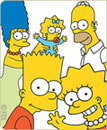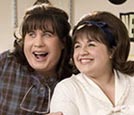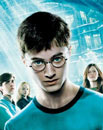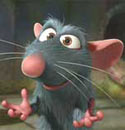July is the month of Big Fun Movies--at least, that’s the goal to which studios aspire. Why they think we’re more up for big fun in the summer than , say, in October, I'm not sure. And in February we could surely use some belly laughs. But I digress. It’s summer, and the entertainment/family factor of the movies is decidedly ratcheted up.
Reviews In This Article
'The Simpsons Movie'
'Hairspray'
'Harry Potter and the Order of the Phoenix'
'Ratatouille'
 This was my 12-year-old son’s most anticipated movie of the summer. I’ll admit, I think "The Simpsons" is one of the best-written, funniest, most moral sitcoms on television these days. It has also engendered some of the deepest conversations my husband and I have had with our children. "Simpsons" humor usually comes from one of two places: Either setting the viewer up to expect one thing, then delivering another (as in the naked Bart on a skateboard section of the movie) or allowing the characters (mostly Homer) to say that which polite adults actually think but would never admit. It also tackles tough issues no other show would touch, and does it with depth and humor.
This was my 12-year-old son’s most anticipated movie of the summer. I’ll admit, I think "The Simpsons" is one of the best-written, funniest, most moral sitcoms on television these days. It has also engendered some of the deepest conversations my husband and I have had with our children. "Simpsons" humor usually comes from one of two places: Either setting the viewer up to expect one thing, then delivering another (as in the naked Bart on a skateboard section of the movie) or allowing the characters (mostly Homer) to say that which polite adults actually think but would never admit. It also tackles tough issues no other show would touch, and does it with depth and humor.
"The Simpson Movie" is very silly and does pack a lot of laughs. It also uses bad language (even Marge finally gets into the act), and cartoon nudity (okay, it’s just Bart). But the movie is never mean-spirited and is often just plain goofy, as when Homer ends up with a pig and makes up a whole "Spider-Pig" action sequence and song to go with it. Whether you should take the kids depends entirely on your view of intelligent, but bawdy humor--the central oxymoron of the series.
I have to admit I came out wondering why, of all the potential plots they had, they went with this one. (Springfield becomes so contaminated that the EPA encases the entire city under a dome). "The Simpsons" is always at its topical best when the humor is character-driven, and Springfield is a certainly a hotbed of characters. I guess they figured they needed an adventure plot and a movie villain to drive the action. Hopefully, with the success of the movie, the writers will have the confidence to do what they do best in the sequel.
Hairspray
 One commentator, explaining "Hairspray's" larger-than-anticipated opening, posited that people of all ages were flocking to see John Travolta. Who are they kidding? Everyone I know, adults included, are going for the infectious music and the completely watchable dancers in the young cast. Movie musicals have morphed into such sophisticated productions that it's mighty nice to find one that has heart as well as a great message--sometimes you've got to do the right thing, even if it costs you.
One commentator, explaining "Hairspray's" larger-than-anticipated opening, posited that people of all ages were flocking to see John Travolta. Who are they kidding? Everyone I know, adults included, are going for the infectious music and the completely watchable dancers in the young cast. Movie musicals have morphed into such sophisticated productions that it's mighty nice to find one that has heart as well as a great message--sometimes you've got to do the right thing, even if it costs you.
"Hairspray" is a movie that takes an American mantra--"it’s what’s inside that counts"--and plays it to its logical (and happy) conclusion. It doesn't just take on racism, although that's the central theme. It also takes on weight-ism and basically anything that lets the status quo dismiss someone on appearance alone.
Tracy Turnblad, the plus-size young heroine of the story, has a wonderful optimism that drives the plot and eventually transforms everyone who's willing to join her on her quest to Oz (in this case an integrated television dance show). She’s able to lure her agoraphobic mother (sweetly played by, yes, John Travolta) outside, gets the black characters to realize some white girls can indeed dance, and the white kids to realize they have a lot of cool moves yet to learn. With the exception of the villainous Velma and Amber (who start out wretched and have nowhere to go except wretched-er) every character has a sweetness just waiting to be tapped. If a movie can make me believe Christopher Walken (the go-to actor for smarmy) has a sweet center, it has really pulled off something big.
There are few movies that get you humming, tapping, and cheering during the film itself, but "Hairspray" manages to pull it off. Yea, Tracy. You go, girl!
 Just before this movie opened, I picked my son up from a week at camp. Driving home, it suddenly struck me--holy cow! He’s so grown up! That was also my overriding feeling as I watched "Harry Potter and the Order of the Phoenix." What a phenomena it has been to watch a whole cast of actors--not only the leads, but their classmates and nemeses--grow up as well. No wonder they feel like a part of the family. We’ve literally known them for years.
Just before this movie opened, I picked my son up from a week at camp. Driving home, it suddenly struck me--holy cow! He’s so grown up! That was also my overriding feeling as I watched "Harry Potter and the Order of the Phoenix." What a phenomena it has been to watch a whole cast of actors--not only the leads, but their classmates and nemeses--grow up as well. No wonder they feel like a part of the family. We’ve literally known them for years."Order of the Phoenix" is the book in which Harry goes from student to teacher and takes his fate into his own hands. It was also the longest book made into the shortest movie, which inevitably means lots of stuff was left out. But it wasn't the missing plot that bothered my neighborhood Potter expert, 11-year-old Erin, it was changed plot. The heart and soul of the Harry Potter books are the relationships between characters--those people you can trust, and those you unexpectedly can or can't trust. So when Harry has his first real girlfriend, and that makes it into the movie, it seems like a plot you have to honor. Erin was upset that the book’s resolution to the relationship didn’t make it into the movie, and Cho got the rap for something that the book explained was someone else’s fault.
Book changes aside, "Order of the Phoenix" does succeed on its own terms. Harry's battle between his anger and his good soul are well played out. Sirius, who was such a shaded character in the last film, only gets to play one note here. (Gary Oldman, exclusively happy and loving? There's something you don't see every day.) Imelda Staunton dominates the movie as the bureaucrat from hell. And I admit that every time I see Ralph Fiennes as Voldemort, I get flashbacks to his virtually identical make-up for "The English Patient."
We saw the film in
Erin also said her favorite film by far was "the one where Harry first meets Sirius"--and I immediately agreed because it’s "the one where he summons the Patronus." "The Prisoner of Azkaban" was the best. It was the one that was most about the complex, wonderful relationships among the characters. The thing is, those relationships, as well as wonder the size of the Patronus spell, are found in every book. The movies succeed to the degree that they find, and let us experience, these relationships for ourselves.
Ratatouille
 If you’ve previously read this column, you probably know that I’m an unabashed fan of Brad Bird, the director/writer of such animated classics as "The Incredibles" and "The Iron Giant" (my all-time favorite animated film). He knows how to spin a vastly entertaining story that contains seeds of morality and great lessons as well. But first and foremost, they are really good, character-driven stories.
If you’ve previously read this column, you probably know that I’m an unabashed fan of Brad Bird, the director/writer of such animated classics as "The Incredibles" and "The Iron Giant" (my all-time favorite animated film). He knows how to spin a vastly entertaining story that contains seeds of morality and great lessons as well. But first and foremost, they are really good, character-driven stories."Ratatouille" is much the same. So what if one of the main characters is a rat? He fits right in with everybody else. My husband, who loves to do gourmet cooking in his spare time, felt "Ratatouille" was the first movie that adequately explained a gourmet's love affair with food--the textures, spices, colors, tastes, and presentation. It is an animated film that captures what it is like in the kitchen of a four-star establishment.
The film follows the adventures of Remy, a young rat who dreams of being a chef. His hero is a dearly-departed gourmand named Gasteau. He ends up in Gasteau’s restaurant, secretly aiding the career of a young cook named Linguini. The animation in the film is incredible, and the characters and story are good. (Although, why a rat would consider it stealing for his family to take food out of the garbage when its destined for the dump, and why Linguini has to finally tell everyone a rat is cooking, were points that were shaded at best.)
The problem with "Ratatouille" is that it had a few too many subplots to be a kid’s movie. It lost every kid I had with me 30 minutes before the story ended, and I’m not sure if it got them back or not. (I was ready for its happy conclusion 20 minutes before it actually ended, myself.) In general, animated films aimed at children should not ruminate. They should move happily along. Other than that, "Ratatouille" is a proud addition to the Brad Bird collection.

